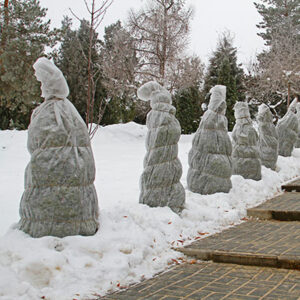Here in northern Delaware, winter weather can be extremely rough on the trees and shrubs you have in your yard. Although some plants are designed to hold up against cold temperatures, icy blasts, and heavy snowfall, most trees and shrubs need a little extra help to make sure they make it through the season. In addition to weather events, your plants might also have to defend themselves from road salt and animal activity threats. If you want to make sure your trees and shrubs are well-prepared for anything nature throws at them this winter, follow these simple steps.
Protecting Root Systems

Even though they are below the ground, the root systems of your trees and shrubs are especially vulnerable during the winter months as they don’t become dormant in the same way the stems, branches, and trunks above the ground do. Additionally, root systems continue to draw water and nutrients from the soil to keep the plant alive during the winter, so protecting them should be your first priority.
Insulate With Mulch
The best way to protect a plant’s root system in the winter is to insulate them. This way, they won’t be affected by cold temperatures. While thick snowfall can help with this, you should take precautions before the snow comes by adding a thick layer of mulch around the base of your trees and shrubs. While well-established plants might not need as much, newly planted or recently transplanted plants should have a three to four-inch layer of mulch around their base. Make sure to apply the mulch in a donut shape, leaving about six inches of space between the trunk or bottom of the plant and the mulch to avoid causing disease or rot.
In Northern Delaware, Young Plants Are Particularly Susceptible
If you have young or recently transplanted plants in your yard, protecting root systems is especially important as these systems are still developing and not very strong. One common problem young plants face in the winter is cracking around the planting hole. This can allow cold air to reach their fragile root systems, delaying growth and potentially killing the plant. You can easily remedy this problem by keeping a close eye on any young plants in your yard and promptly filling in any cracks with soil. Additionally, if you expect frequent freezing and thawing, you should increase the mulch layer to four to six inches to prevent frost heaving from damaging the roots of young plants and small shrubs.
Protecting Deciduous Trees And Shrubs

Sunscald
One of the biggest problems deciduous trees and shrubs have during the winter is sunscald, which occurs when the sun warms up a tree’s bark and stimulates new growth around cracks or weak points. Once the sun goes down or behind a cloud, the temperature of the bark can drop very quickly, killing the new growth and damaging the tree. Trees and shrubs that are young, recently transplanted or pruned, or have thin bark are more likely to have issues with sunscald. To avoid this issue, use a reflective tree wrap or guard that will help regulate the plant’s bark temperature.
Dieback
Another problem that deciduous plants experience in the winter is dieback. Any new growth won’t have as much protection as other parts of the plant, making it vulnerable to cold temperatures. Not much can be done to prevent this problem, so make sure you place plants that are only marginally winter-hardy in a location that offers them shelter from winter conditions. You should also avoid any activities that can cause plants to produce new growth, such as pruning, fertilizing, and overwatering after the end of summer.
Protecting Evergreen Plants
Winter damage to evergreen trees and shrubs most often occurs as discoloration of the foliage that can be caused by excessive water loss, bright sunny days, and too cold temperatures. To avoid this problem, use leftover trimmed branches, Christmas tree trimmings, or a barrier made from a fabric like a burlap to protect the sides and base of the plant from the wind and sun.
Quick Tips For Avoiding Damage From Snow, Ice, Salt, And Animals
- Wrapping the branches of small trees and shrubs, as well as proper pruning in earlier seasons can help prevent heavy damage from heavy snowfall.
- Don’t try to remove ice from a tree, as this can be dangerous for both you and your plant.
- De-icing salt can splash from the roadway onto your trees and shrubs, potentially harming their health. Guards or barriers around plants located near the street can keep this problem from occurring.
- Small rodents and even larger animals like deer might try to nibble on your trees and shrubs during the winter months when food is scarce, so use plastic, wire, or cloth guards to keep them at bay.
For All Your Landscape Needs in Northern Delaware, Call Quality Cut Lawn Service
Trees and shrubs are a big investment for your property, and if you’ve taken the time to make sure they are well protected from winter weather conditions in northern Delaware, you probably want the rest of your landscape to get the same attention. The professionals at Quality Cut Lawn Service specialize in customized landscape design and installation to help you achieve your ideal yard, increase your home’s curb appeal, and make your outdoor living space one you love to spend time in. Whether you want to create a natural habitat for native species, you’re looking for a fresh update for your landscape, or you just want to beautify your yard so that it really stands out, we can help.
Visit our website to see more information on our landscape design and installation options and all of our other lawn care services, fill out our contact form online, or give us a call at 302-420-7597. And don’t forget to keep reading our monthly blog for more helpful articles on caring for your lawn and garden!
